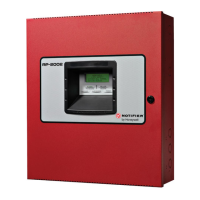Honeywell ###!b.cE
gain programmed and routed as a VPATH command (Figure 260,
sheet 7). TAS gain programming accurately adjusts the VPATH
command signal as a function of the aircraft’s current speed
and barometric altitude.
The VPATH command signal will drive
the flight director pitch command cue on the PFD in the proper
direction to fly the aircraft back to the prescribed path. As
the aircraft returns to the prescribed path, the VPATH command
will decrease towards zero.
The aircraft has now returned to
the prescribed path.
For discussion of the VPATH command
signal as it is processed (as shown in Figure 260, sheet 7,
refer to paragraph 3.B.(8)(i).
3. B. (8) (e) ~~~~;u~e)Hold and VNAV Altitude Hold Modes (See Figure 260,
.
Activation of the ALT HLD pushbutton on the GP-820 Flight
Guidance Controller selects the altitude hold mode and
overrides all active pitch F/D modes. The altitude hold mode
is annunciated on the PFD by a green ALT.
Activation of the VNAV ARM and ALT HOLD pushbuttons on the
GP-820 Flight Guidance Controller selects the VNAV altitude
hold mode and overrides all active pitch F/D modes. The VNAV
altitude hold mode is annunciated on the PFD by a green VALT.
Activation ofALT or VALT modes is automatic after either an
altitude preselect capture (ASEL) or VNAV altitude preselect
capture (VASEL).
In the ALT or VALT mode, all armed pitch F/D modes are allowed,
but a capture of any armed pitch mode will override the ALT or
VALT mode. To allow the initiation or the continuation of the
mode, the selected DADC must be valid.
ALT and VALT modes are vertical axis flight director modes used
to maintain a barometric altitude reference. The vertical axis
of the flight director will maintain the barometric altitude at
the time of mode engagement. The reference altitude may be
changed by using TCS to maneuver to a new altitude and then
releasing the TCS button. Using the pitch wheel on the PC-880
cancels the ALT mode.
Prior to mode engagement, barometric altitude information
provided by the selected DADC is routed through a summing
junction and a closed ALT HOLD + TCS switch to the input of the
altitude hold reference synchronizer.
The synchronizer
develops an output equal in amplitude but opposite in polarity
to its input. The synchronizer output will sum with and cancel
the actual altitude information resulting in the altitude
reference signal continually being synchronized to zero prior
to mode engagement.
22-14-00
Page 298:114
Aug 15/91
Use or disclosure of information on this page is subject to the restrictions on the title page of thm document.

